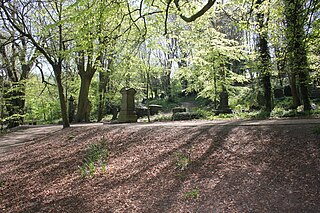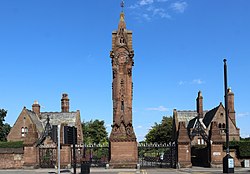
The General Cemetery in the City of Sheffield, England opened in 1836 and closed for burial in 1978. It was the principal cemetery in Victorian Sheffield with over 87,000 burials. Today it is a listed Landscape on the English Heritage National Register of Historic Parks and Gardens. It is also a Local Nature Reserve. It is owned by the City of Sheffield and managed on behalf of the city by a local community group, the Sheffield General Cemetery Trust.

Everton Cemetery, in Long Lane, Fazakerley, Liverpool, opened in July 1880.
Liverpool in England has a significant number of public parks and gardens. The Register of Historic Parks and Gardens of Special Historic Interest in England describes the city's collection of Victorian parks as the "most important in the country". Liverpool has 10 listed parks and cemeteries, including two Grade I and five Grade II*, more than any other UK city except London. There are over 2,500 acres (10 km2) of parks and open spaces in the city.

The City of London Cemetery and Crematorium is a cemetery and crematorium in the east of London. It is owned and operated by the City of London Corporation. It is designated Grade I on the Historic England National Register of Historic Parks and Gardens.

The architecture of Liverpool is rooted in the city's development into a major port of the British Empire. It encompasses a variety of architectural styles of the past 300 years, while next to nothing remains of its medieval structures which would have dated back as far as the 13th century. Erected 1716–18, Bluecoat Chambers is supposed to be the oldest surviving building in central Liverpool.

Liverpool is a city and port in Merseyside, England, which contains many listed buildings. A listed building is a structure designated by English Heritage of being of architectural and/or of historical importance and, as such, is included in the National Heritage List for England. There are three grades of listing, according to the degree of importance of the structure. Grade I includes those buildings that are of "exceptional interest, sometimes considered to be internationally important"; the buildings in Grade II* are "particularly important buildings of more than special interest"; and those in Grade II are "nationally important and of special interest". Very few buildings are included in Grade I — only 2.5% of the total. Grade II* buildings represent 5.5% of the total, while the great majority, 92%, are included in Grade II.
Liverpool is a city and port in Merseyside, England, which contains many listed buildings. A listed building is a structure designated by English Heritage of being of architectural and/or of historical importance and, as such, is included in the National Heritage List for England. There are three grades of listing, according to the degree of importance of the structure. Grade I includes those buildings that are of "exceptional interest, sometimes considered to be internationally important"; the buildings in Grade II* are "particularly important buildings of more than special interest"; and those in Grade II are "nationally important and of special interest". Very few buildings are included in Grade I — only 2.5% of the total. Grade II* buildings represent 5.5% of the total, while the great majority, 92%, are included in Grade II.
Liverpool is a city and port in Merseyside, England, which contains many listed buildings. A listed building is a structure designated by English Heritage of being of architectural and/or of historical importance and, as such, is included in the National Heritage List for England. There are three grades of listing, according to the degree of importance of the structure. Grade I includes those buildings that are of "exceptional interest, sometimes considered to be internationally important"; the buildings in Grade II* are "particularly important buildings of more than special interest"; and those in Grade II are "nationally important and of special interest". Very few buildings are included in Grade I — only 2.5% of the total. Grade II* buildings represent 5.5% of the total, while the great majority, 92%, are included in Grade II.
Liverpool is a city and port in Merseyside, England, which contains many listed buildings. A listed building is a structure designated by English Heritage of being of architectural and/or of historical importance and, as such, is included in the National Heritage List for England. There are three grades of listing, according to the degree of importance of the structure. Grade I includes those buildings that are of "exceptional interest, sometimes considered to be internationally important"; the buildings in Grade II* are "particularly important buildings of more than special interest"; and those in Grade II are "nationally important and of special interest". Very few buildings are included in Grade I — only 2.5% of the total. Grade II* buildings represent 5.5% of the total, while the great majority, 92%, are included in Grade II.
There are over 2500 listed buildings in Liverpool, England. A listed building is one considered to be of special architectural, historical or cultural significance, which is protected from being demolished, extended or altered, unless special permission is granted by the relevant planning authorities. Of the listed buildings in Liverpool, at least 85 are classified as Grade II* listed and are recognised as being particularly important with more than special architectural or historic interest. The following list provides information on all the Grade II* listed buildings located in all the L postcodes outside the city centre.

Merseyside is a metropolitan county in North West England. It was created by the Local Government Act 1972, and consists of the metropolitan boroughs of Knowsley, St Helens, Sefton, Wirral, and the city of Liverpool. Buildings are listed on the recommendation of English Heritage to the Secretary of State for Culture, Media and Sport, who makes the decision whether or not to list the structure. Grade I listed buildings are defined as being of "exceptional interest, sometimes considered to be internationally important"; only 2.5 per cent of listed buildings are included in this grade. This is a complete list of Grade I listed churches in the metropolitan county of Merseyside as recorded in the National Heritage List for England.
Tyldesley is a town in the Metropolitan Borough of Wigan, in Greater Manchester, England. It contains several listed buildings designated by English Heritage and included in the National Heritage List for England. Most are listed at Grade II, the lowest of the three gradings given to listed buildings and is applied to "buildings of national importance and special interest".
Walton is a civil parish in the Borough of Warrington in Cheshire, England. It contains 22 buildings that are recorded in the National Heritage List for England as designated listed buildings. The parish is centred on Walton Hall, the former home of the Greenall family. The hall itself is listed, as are surrounding structures related to the hall. Also listed are the nearby parish church and its lychgate, and cottages and a former school in the Walton Hall Estate. The Bridgewater Canal runs through the parish; related to this are six listed structures, namely five bridges and an aqueduct. The other listed buildings are a former farmhouse dating from about 1800, a late 18th-century house, and an early 19th-century farmhouse. All the buildings are listed at Grade II, other than the parish church which is listed at Grade II*.

St Mary's Church is in Walton, Liverpool, Merseyside, England. It is an active Anglican parish church in the deanery of Walton, the archdeaconry of Liverpool and the diocese of Liverpool. Its benefice is united with those of St Nathanael, Walton-on-the-Hill, and St Aidan, Walton-on-the-Hill, to form the Walton Team Ministry. The church is recorded in the National Heritage List for England as a designated Grade II listed building.
St Helens is a town in the Metropolitan Borough of St Helens, Merseyside, England. The unparished area contains 67 buildings that are recorded in the National Heritage List for England as designated listed buildings. Of these, one is listed at Grade I, the highest grade, five are listed at Grade II*, the middle of the three grades, and the others are at Grade II, the lowest grade. The main town in the district is St Helens, the others being Newton-le-Willows and Earlestown. Until the Industrial Revolution, the area was largely rural. Coal mining began in the 16th century, but modern industrial development began with the construction of the Sankey Canal in the late 18th century, linking St Helens with the River Mersey. The early 19th century saw new industries, including copper smelting, production of alkali, and the manufacture of glass. Of these, the major industry was glass making, the main business being that of Pilkingtons. The first major railway line in the world, the Liverpool and Manchester Railway was built through the district, opening in 1830.

Ince Blundell Hall is a former country house near the village of Ince Blundell, in the Metropolitan Borough of Sefton, Merseyside, England. It was built between 1720 and 1750 for Robert Blundell, the lord of the manor, and was designed by Henry Sephton, a local mason-architect. Robert's son, Henry, was a collector of paintings and antiquities, and he built impressive structures in the grounds of the hall in which to house them. In the 19th century the estate passed to the Weld family. Thomas Weld Blundell modernised and expanded the house, and built an adjoining chapel. In the 1960s the house and estate were sold again, and have since been run as a nursing home by the Canonesses of St. Augustine of the Mercy of Jesus.
Up Holland is a civil parish in the West Lancashire district of Lancashire, England. It contains 97 buildings that are recorded in the National Heritage List for England as designated listed buildings. Of these, one is listed at Grade I, the highest of the three grades, four are at Grade II*, the middle grade, and the others are at Grade II, the lowest grade. The parish contains the village of Up Holland and surrounding countryside. The oldest surviving structure in the parish is Up Holland Priory, the chancel of which was converted into the nave of the Church of St Thomas the Martyr; both of these are listed. Most of the other listed buildings are houses, cottages and associated structures, and buildings that are farmhouses and farm buildings. The Liverpool and Bury Railway Company built a railway through the parish and, associated with this and listed, are two bridges and two tunnel portals. The other listed buildings include public houses, more churches, a former windmill, schools and colleges, a war memorial and a telephone kiosk.
Ince-in-Makerfield is a town in the Metropolitan Borough of Wigan, Greater Manchester, England. The town and the surrounding area contains eight listed buildings that are recorded in the National Heritage List for England. All the listed buildings are designated at Grade II, the lowest of the three grades, which is applied to "buildings of national importance and special interest".
Manchester is a city in Northwest England. The M21 postcode area of the city includes the suburb of Chorlton-cum-Hardy. This postcode area contains 19 listed buildings that are recorded in the National Heritage List for England. Of these, one is listed at Grade II*, the middle of the three grades, and the others are at Grade II, the lowest grade. The area is mainly residential. It also contains Southern Cemetery, and a number of buildings associated with this are listed, including structures at the entrance, the chapels, a memorial, and the crematorium. Most of the other listed buildings are houses, and also included are a church, a public house and hotel, the gateway to a former church, a library, and a war memorial.












